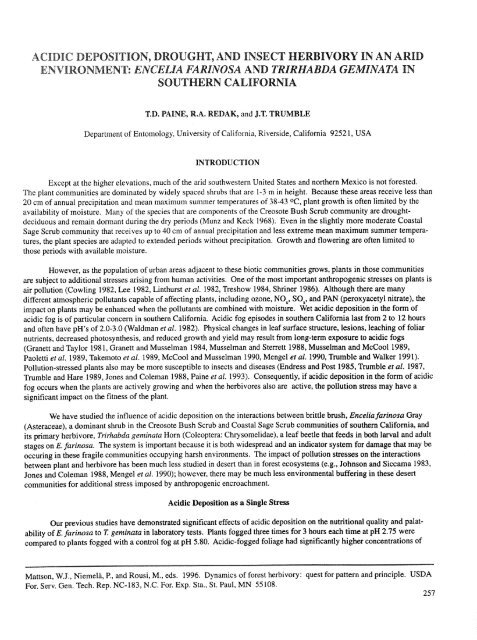View or print this publication - Northern Research Station - USDA ...
View or print this publication - Northern Research Station - USDA ...
View or print this publication - Northern Research Station - USDA ...
Create successful ePaper yourself
Turn your PDF publications into a flip-book with our unique Google optimized e-Paper software.
ACIDIC DEPOSITION, DROUGHT, AND INSECT HERBIVORY IN AN ARID<br />
ENVIRONMENT: ENCELIA FARINOSA AND TRIRHABDA GEMINATA IN<br />
SOUTHERN CALIFORNIA<br />
T.D. PAINE, R.A. REDAK, and J.T. TRUMBLE<br />
Department of Entomology, University of Calif<strong>or</strong>nia, Riverside, Calif<strong>or</strong>nia 92521, USA<br />
INTRODUCTION<br />
Except at the higher elevations, much of the arid southwestern United States and n<strong>or</strong>thern Mexico is not f<strong>or</strong>ested.<br />
The plant communities are dominated by widely spaced shrubs that are 1-3 m in height. Because these areas receive less than<br />
20 cm of annual precipitation and mean maximum summer temperatures of 38-43 °C, plant growth is often limited by the<br />
availability of moisture. Many of the species that are components of the Creosote Bush Scrub community are droughtdeciduous<br />
and remain d<strong>or</strong>mant during the dry periods (Munz and Keck 1968). Even in the slightly m<strong>or</strong>e moderate Coastal<br />
Sage Scrub community that receives up to 40 cm of annual precipitation and less extreme mean maximum summer temperatures,<br />
the plant species are adapted to extended periods without precipitation. Growth and flowering are often limited to<br />
those periods with available moisture.<br />
However, as the population of urban areas adjacent to these biotic communities grows, plants in those communities<br />
are subject to additional stresses arising from human activities. One of the most imp<strong>or</strong>tant anthropogenic stresses on plants is<br />
air pollution (Cowling 1982, Lee 1982, Linthurst et al. 1982, Treshow 1984, Shriner 1986). Although there are many<br />
different atmospheric pollutants capable of affecting plants, including ozone, NO x, SO, and PAN (peroxyacetyl nitrate), the<br />
impact on plants may be enhanced when the pollutants are combined with moisture. Wet acidic deposition in the f<strong>or</strong>m of<br />
acidic fog is of particular concern in southern Calif<strong>or</strong>nia. Acidic fog episodes in southern Calif<strong>or</strong>nia last from 2 to 12 hours<br />
and often have pH's of 2.0-3.0 (Waldman et al. 1982). Physical changes in leaf surface structure, lesions, leaching of foliar<br />
nutrients, decreased photosynthesis, and reduced growth and yield may result from long-term exposure to acidic fogs<br />
(Granett and Tayl<strong>or</strong> 1981, Granett and Musselman 1984, Musselman and Sterrett 1988, Musselman and McCool 1989,<br />
Paoletti et al. 1989, Takemoto et al. 1989, McCool and Musselman 1990, Mengel et al. 1990, Trumble and Walker 1991).<br />
Pollution-stressed plants also may be m<strong>or</strong>e susceptible to insects and diseases (Endress and Post 1985, Trumble et al. 1987,<br />
Trumble and Hare 1989, Jones and Coleman 1988, Paine et al. 1993). Consequently, if acidic deposition in the f<strong>or</strong>m of acidic<br />
fog occurs when the plants are actively growing and when the herbiv<strong>or</strong>es also are active, the pollution stress may have a<br />
significant impact on the fitness of the plant.<br />
We have studied the influence of acidic deposition on the interactions between brittle brush, Enceliafarinosa Gray<br />
(Asteraceae), a dominant shrub in the Creosote Bush Scrub and Coastal Sage Scrub communities of southern Calif<strong>or</strong>nia, and<br />
its primary herbiv<strong>or</strong>e, Trirhabda geminata H<strong>or</strong>n (Coleoptera: Chrysomelidae), a leaf beetle that feeds in both larval and adult<br />
stages on E. farinosa. The system is imp<strong>or</strong>tant because it is both widespread and an indicat<strong>or</strong> system f<strong>or</strong> damage that may be<br />
occuring in these fragile communities occupying harsh environments. The impact of pollution stresses on the interactions<br />
between plant and herbiv<strong>or</strong>e has been much less studied in desert than in f<strong>or</strong>est ecosystems (e.g., Johnson and Siccama 1983,<br />
Jones and Coleman 1988, Mengel et al. 1990); however, there may be much less environmental buffering in these desert<br />
communities f<strong>or</strong> additional stress imposed by anthropogenic encroachment.<br />
Acidic Deposition as a Single Stress<br />
Our previous studies have demonstrated significant effects of acidic deposition on the nutritional quality and palatability<br />
of E. farinosa to Z geminata in lab<strong>or</strong>at<strong>or</strong>y tests. Plants fogged three times f<strong>or</strong> 3 hours each time at pH 2.75 were<br />
compared to plants fogged with a control fog at pH 5.80. Acidic-fogged foliage had significantly higher concentrations of<br />
Mattson, W.J., Niemel_i, E, and Rousi, M., eds. 1996. Dynamics of f<strong>or</strong>est herbiv<strong>or</strong>y: quest f<strong>or</strong> pattern and principle. <strong>USDA</strong><br />
F<strong>or</strong>. Serv. Gen. Tech. Rep. NC-183, N.C. F<strong>or</strong>. Exp. Sta., St. Paul, MN 55108.<br />
257
















